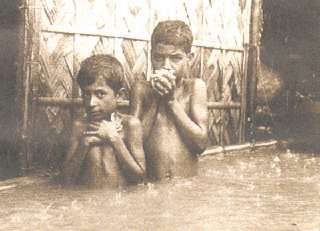Where: New Delhi, India
Every day, Indian newspapers carry reports that large parts of Bihar, Bengal and north-east India are flooded, causing loss to human and animal lives, and property. This happens year after year. What is the reason for these floods? An indepth report from ‘Gobar Times’, a children’s magazine on the environment brought out by the Delhi-based Centre for Science and Environment.

May 12, 2000: The mighty Himalayas get knocked out by the monsoon system every year. For four months in a year, the mountains get a concentrated battering by two gargantuan blue-grey fists — the Bay of Bengal monsoon current and the Arabian Sea current. As an opponent, the Himalayas are very big, but not very strong. After all, they once used to be the bottom of the sea, just sand and slimy sediments!
When the monsoon slams into the Himalayas, it deposits 80 per cent of the year’s rain in a short span of 60 days, from July to September. The Himalayas are soft and geologically very fragile. Cut and gouged mercilessly by the streams and rivers that flow off its slopes, these rivers dump their soil when they suddenly come in contact with flatter land.
The Ganga-Brahmaputra-Meghna Basin
The Indian monsoon strengthens two giant glacier-fed rivers that originate in the Himalayas — the Ganga and the Brahmaputra. The Meghna-Barak joins them at Dhaka, the capital of Bangladesh. They form the Ganga-Brahmaputra-Barak (GBM) Basin. The GBM Basin system carries the most water after the Amazon and Congo basins. More than half a billion people, nearly a tenth of all humans, reside in this basin, amongst the most fertile in the world.
The quantity of water in the Ganga and the Brahmaputra shoots up (over ten times) between July and September. Fortunately, the peak periods are a few weeks apart. Can you imagine what happens when these peak periods coincide?
Rivers in the GBM Basin experience floods mainly due to:
— Loose, crumbly soil in the mountain ranges where the rivers originate, and excessive silt loads in the rivers.
— A rainfall pattern peculiar to monsoon lands, i.e. 80 per cent of the annual rainfall concentrated in three months of the year.
— Steep slopes that suddenly flatten out. This causes the river and its tributaries to drop their loads of silt. This raises the level of the river bed so that its contents spill over onto its banks, causing floods.
Floods in the Hills
Heavy monsoon rains, sparse vegetation and loose Himalayan soil is a perfect formula for landslides. Landslides dam the rivers creating massive lakes, which sooner or later burst and send a devastating flood pulse down the river valley.
In 1893, a landslide dammed the Birahiganga where it meets the Alaknanda, creating a massive lake. The dam burst 10 months later, raising the Alaknanda’s level by 50 metres, washing away Srinagar town (in Garhwal, not the one in Kashmir).
After the Flood: The Fertile Land
The Himalayan rivers come to the plains swollen with silt. They drop their loads as the floods recede and leave behind huge tracts of land exposed, usually adjacent or as islands in the river. These are the ‘diara’ (in Bihar and eastern Uttar Pradesh) and ‘khadar’ (in western Uttar Pradesh) lands. Even as the river builds ‘diara’ land on one bank, it swings around to engulf vast tracts of land on the other.
‘Diara’ land is fertile as the sandy veneer recedes away from the river. Precious cereals and pulses are grown here, as well as melons, pumpkin and bottle gourd. Yet people have to be prepared to shift with the mood of the river.
Life here is a continuous search for a place to settle. This scarcity of land is a far more dangerous opponent than the river itself. People fight and even murder to gain control of these shifting lands.
645 words |
6 minutes
Readability:
Grade 7 (12-13 year old children)
Based on Flesch–Kincaid readability scores
Filed under: world news
Tags: #india, #rivers, #floods, #monsoons, #ganga, #himalayas
You may also be interested in these:
They Make you Swallow a Fish for a Herbal Cure
A Baby Lion Learns To Roar
The Telegraph
Snake People
Gems of Indian Literature